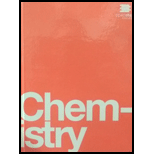
Concept explainers
Explain how
Interpretation: To explain how the sigma (s) and pi (p) bonds are similar and different.
Concept introduction: A sigma bond is formed by the axial overlap of atomic orbitalsand the pi bonds are formed by the side-to-side overlap of p-orbitals.
Answer to Problem 1E
Similarities: Both sigma and pi bonds are formed by the overlapping of orbital and these bonds are covalent bonds.
Differences: Sigma bond is the strong bond whereas pi bond is weaker in comparison to sigma bond.
Pi bond is formed by the side to side overlapping of atomic orbital whereas sigma bond is formed by the linear (end to end) overlapping of atomic orbital.
Explanation of Solution
The sigma and pi both the bonds are formed by sharing of an electron pair that is both are covalent bonds. The sigma bond is formed when two orbitals overlap axially along the internuclear axis; it is strong bond as it requires very high energy to break. The sigma bonds of molecules give the shape of a molecule as per VSEPR model. The sigma bonds can rotate but the pi bonds cannot because if a pi bond is rotated it will break.
Therefore, the similarity between sigma and pi bonds are that both are formed by the overlap of orbital and both the bonds are covalent bonds that is it involves a bond pair. The difference between sigma and pi bonds are that sigma bond is the strongest bond while pi bonds are weaker as compared to sigma bond. Sigma bond is formed by linear overlap of atomic orbital while the pi bond is formed by side-to-side overlap of atomic orbital. Sigma bond gives the shape while a pi bond gives the length of a molecule. Sigma bond is free to rotate around its axis while the pi bond cannot rotate it is locked.
Similarities: Both sigma and pi bonds are formed by the overlapping of orbital and these bonds are covalent bonds.
Differences: Sigma bond is the strong bond whereas pi bond is weaker in comparison to sigma bond.
Pi bond is formed by the side to side overlapping of atomic orbital whereas sigma bond is formed by the linear (end to end) overlapping of atomic orbital.
Want to see more full solutions like this?
Chapter 8 Solutions
Chemistry by OpenStax (2015-05-04)
Additional Science Textbook Solutions
College Physics
Chemistry: A Molecular Approach (4th Edition)
Organic Chemistry (8th Edition)
Organic Chemistry
Chemistry: A Molecular Approach
Chemistry: The Central Science (13th Edition)
- • identify sigma and pi bonds in a molecule and explain the difference between them.arrow_forwardAmong the following, which has the shortest bond and which has the longest: Li2, B2, C2, N2, O2?arrow_forwardIn each of the following molecules, a central atom is surrounded by a total of three atoms or unshared electron pairs: SnCl2, BCl3, SO2. In which of these molecules would you expect the bond angle to be less than 120? Explain your reasoning.arrow_forward
- Consider the following molecules: SiH4, PH3, H2S. In each case, a central atom is surrounded by four electron pairs. In which of these molecules would you expect the bond angle to be less than 109.5? Explain your reasoning.arrow_forwardWhich of these molecules have an odd number of valence electrons: NO2, SCl2, NH3, NO3?arrow_forwardThe most stable forms of the nonmetals in groups 4A, 5A, and 6A of the first period are molecules with multiple bonds. Beginning with the second period, the most stable forms of the nonmetals of these groups are molecules without multiple bonds. Propose an explanation for this observation based on valence bond theory.arrow_forward
- how many pi and sigma bonds are there?arrow_forwardDefine bond order? What does it tells .arrow_forwardTwo different molecules have the formula XeF2Cl2. Write Lewis structures for these two compounds, and describe how measurement of dipole moments might be used to distinguish between them.arrow_forward
- The table below shows the electronic arrangements of four atoms. Atom Electronic arrangement P 2,5 Q 2,6 R 2,7 S 2,8 Which of the following atoms is the most probable to form a single bond in the molecule of its element? A. P B. Q C. R D. Sarrow_forwardCalculate; The energy required to excite an electron from level n = 1 to level n = 4. By use of NH3, explain why electronic geometry is NOT the same as molecular geometry.arrow_forwardHow many Sigma and how many pi bonds are in the following molecule?arrow_forward
 Chemistry for Engineering StudentsChemistryISBN:9781337398909Author:Lawrence S. Brown, Tom HolmePublisher:Cengage Learning
Chemistry for Engineering StudentsChemistryISBN:9781337398909Author:Lawrence S. Brown, Tom HolmePublisher:Cengage Learning Chemistry & Chemical ReactivityChemistryISBN:9781133949640Author:John C. Kotz, Paul M. Treichel, John Townsend, David TreichelPublisher:Cengage Learning
Chemistry & Chemical ReactivityChemistryISBN:9781133949640Author:John C. Kotz, Paul M. Treichel, John Townsend, David TreichelPublisher:Cengage Learning Chemistry & Chemical ReactivityChemistryISBN:9781337399074Author:John C. Kotz, Paul M. Treichel, John Townsend, David TreichelPublisher:Cengage Learning
Chemistry & Chemical ReactivityChemistryISBN:9781337399074Author:John C. Kotz, Paul M. Treichel, John Townsend, David TreichelPublisher:Cengage Learning Chemistry: The Molecular ScienceChemistryISBN:9781285199047Author:John W. Moore, Conrad L. StanitskiPublisher:Cengage Learning
Chemistry: The Molecular ScienceChemistryISBN:9781285199047Author:John W. Moore, Conrad L. StanitskiPublisher:Cengage Learning Chemistry: Principles and PracticeChemistryISBN:9780534420123Author:Daniel L. Reger, Scott R. Goode, David W. Ball, Edward MercerPublisher:Cengage LearningChemistry: Matter and ChangeChemistryISBN:9780078746376Author:Dinah Zike, Laurel Dingrando, Nicholas Hainen, Cheryl WistromPublisher:Glencoe/McGraw-Hill School Pub Co
Chemistry: Principles and PracticeChemistryISBN:9780534420123Author:Daniel L. Reger, Scott R. Goode, David W. Ball, Edward MercerPublisher:Cengage LearningChemistry: Matter and ChangeChemistryISBN:9780078746376Author:Dinah Zike, Laurel Dingrando, Nicholas Hainen, Cheryl WistromPublisher:Glencoe/McGraw-Hill School Pub Co





